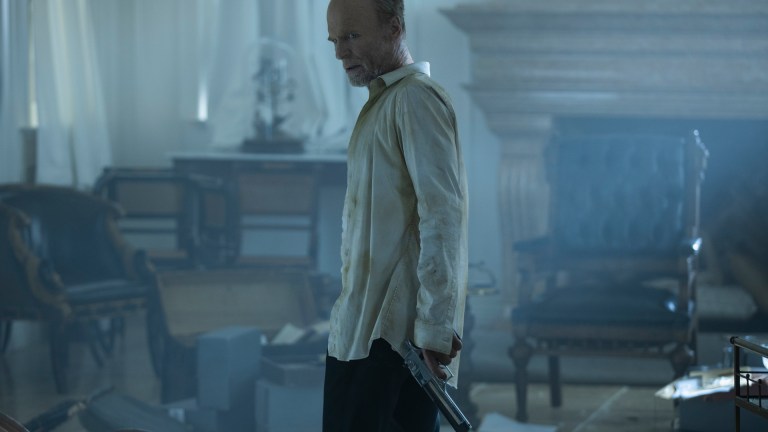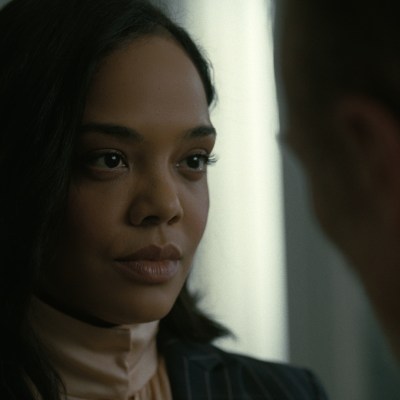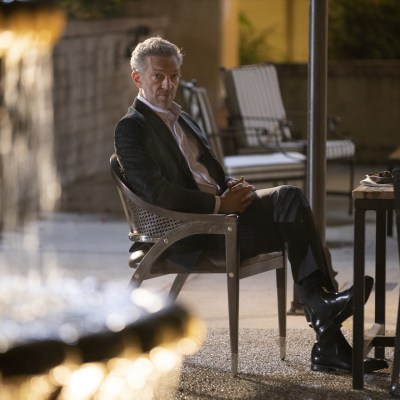Westworld Season 3: William Starts Another Loop
William a.k.a. The Man in Black (Ed Harris) has already lived through his cornerstone memory. What is left for him in Westworld season 3?

The following contains Westworld season 3 episode 4 spoilers.
At first glance, it’s not immediately clear why Ed Harris’ William a.k.a. the Man in Black is still part of Westworld. Sure, the character was a near-iconic figure in the show’s first two seasons, when the majority of its story was still set in the Delos theme park that gives it its name. There, William was a larger than life figure, a Wild West villain come to life who spent the majority of his time hunting mysterious in-game secrets that only he believed were real.
But in Season 3, Westworld’s focus has shifted to “our” world, a technocratic nightmare vision of 2058 in which humans’ lives are as scripted as any fictional host narrative has ever been. Dolores escaped Westworld to try and (maybe?) kickstart a robot uprising in this world she was always forbidden to see, hatching a complicated plan of revenge that somehow involves multiple copies of herself and a new human partner in lost soul Caleb Nichols. Elsewhere, Maeve has arrived in the real world to track down Dolores on behalf of shady trillionaire Engerraund Serac, who wants the guest data she stole from The Forge last season.
Three full episodes pass before the Man in Black even appears onscreen, and his eventual return in episode 4, “The Mother of Exiles,” still sees him largely separated from the main season 3 story, physically isolated in his palatial home and arguing with voices in his head. Though William interacts with Dolores-as-Charlotte long enough to get tricked out of both his freedom and the majority holding of his company, one doesn’t really get the sense that he’s meant to play a role in her quest to gain access to the superpowered AI known as Rehoboam. In truth, the story of season 3 could and did easily take place without William entirely, which certainly begs the question —why is he here now?
If the Man in Black is generally superfluous to needs for the “modern-day” story of Westworld season 3, it therefore seems safe to assume that his presence is meant to explore larger issues outside of the brewing robot showdown between Dolores and Maeve. William’s story, after all, has always been connected to the big philosophical questions this show has always loved to dance around—identity, free will and determinism. Are we all doomed to our predetermined narrative loops forever, robots and humans alike? Or can we break them, and in the process become something more than we once were? Is it possible, as Maeve and Dolores have both insisted, to write our own stories in the end?
This question is central to the Man in Black’s journey. William’s infatuation with Westworld always stemmed from his most human desires—his to ascribe a deeper meaning to the world around him and his own place in it. Whether that means believing Dolores contains hidden humanity or searching for the Valley Beyond, he has always been a character seeking things that lie beneath the surface of what is visible. He desperately needs to believe that his story matters, and that there is and always has been some purpose to the things he has both done and endured.
William’s presence in season 3 certainly indicates that this quest is far from over. His insistence that he both knows who he is and understands what’s real, even as his increasingly volatile mental state has him seeing visions and contemplating suicide, is a story that’s both compelling and tragic.
“Which one is it? Are you free and evil?” William’s Emily hallucination asks him. “Or blameless and helplessly enslaved?”
But Emily’s question is badly miscast as merely a binary choice. As a series of ones and zeros rather than a lifetime’s worth of experiences and choices that make up the totality of a person. William’s journey is messy, complicated, and dark, yes. But it is also an affirmation, proof that we can – should we choose to – still make a difference in our own lives. That the choices we make can still change things, that we aren’t entirely irredeemable, even if only for the briefest of moments.
The Man in Black’s determination to prove that he is indelibly himself, that no machine can tell him who he is, is a strangely hopeful note in Season 3. Yes, William is a monster who has done terrible things. But he wore a white hat before he ever put on a black one, and now he seems to wear no hat at all. William is, after all, one of the few Westworld characters we’ve seen who has proven capable of breaking out of the predetermined loops they’re in. Even Maeve and Dolores, despite their best efforts, often find themselves repeating patterns and loops we’ve seen before. (Just look at how many visual call backs to season 1 are sprinkled through season 3’s first episodes.)
When we first see the Man in Black this season, viewers can immediately see the breadth of William’s mental deterioration, from his visions of his dead daughter to his fractured awareness of who and where he is. As he struggles to maintain his grip on reality, there’s a quick glimpse of season 1 Dolores in her blue dress—clearly his preferred way to remember her since that’s also the way she appears to him at the end of the episode. We also see William visualize two key moments from previous seasons; one a strange self-insert recreation of his wife’s suicide complete with overflowing bathtub, and another in the form of scenes from season 2 episode “The Riddle of the Sphinx.”
That particular installment is notable for many reasons, but mostly for the fact that it’s the first time we see the Man in Black purposefully decide to break his own loop. On his second trip to Las Mudas, he becomes the hero instead of the villain, rescuing Lawrence’s wife and family from a murderous Craddock, who just so happens to be filling the very same role William himself performed once before. Right down to the very same lines and positioning.
In recalling these moments, Westworld clearly wants to remind us that even though William is the series’ designated villain, that was not always the case. He was once a boy who loved a girl, and a man who tried to do good, and both those things remained true, even as he lost himself to the darkness inside him, and told himself it was simply part of who he was. Until he didn’t. Until he tried something else.
Thanks to the flash forward at the end of season 2, we’ve already seen that there’s a host version of William who’s still reliving his season 2 trip through the park in an attempt to find a path that doesn’t result in Emily’s death. We know that somewhere, some version of William may yet spend hundreds of years trying to fix his worst mistake. He will never achieve this, of course. But the fact that he’s trying matters.
At the end of “The Mother of Exiles,” William is once again alone, save for the presence of another of the imaginary women in his life. His desperate plea for Dolores to tell him whether he is, in fact, himself, is surprisingly moving, simply because it implies that after all this time, and all his choices, he still doesn’t know. Perhaps the Maze was never meant for him, but this third iteration of the story clearly is – and how and whether he finds the answer could impact the future of how we see humanity in this story. Welcome to the end of the game, indeed. Here’s hoping there might possibly be some peace there.


